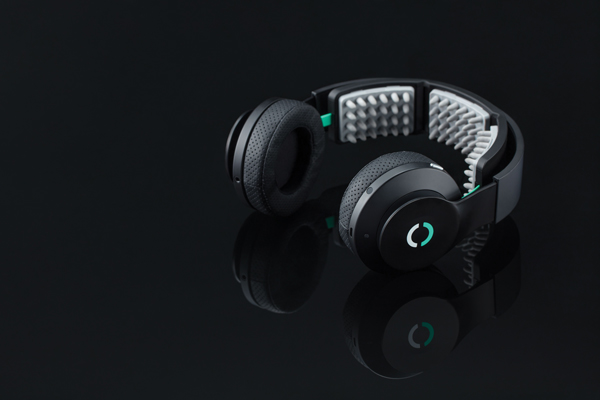 |
Halo Sport’s headphones provide a series of electric pulses to the head in an effort to create deeper and stronger signals between the user’s brain and muscles.
Photo by: HALO SPORT
|
The Halo Sport, on the surface, looks like any high-end pair of headphones, and indeed, the product does play music and its sleek, black look is not unlike Beats by Dre or other popular models.
But Dr. Daniel Chao’s product is really what he calls “a protein shake for the brain,” and he seeks to establish a whole new realm of athletic training that is based on the mind instead of the body.
 |
| Chao |
Chao is chief executive and co-founder of San Francisco-based Halo Neuroscience, and the company’s $699 Halo Sport operates in what it calls “neuropriming.” The product when worn provides a series of mild electric pulses that create a warm, tingling sensation on top of the head. Those pulses seek to develop deeper signals and stronger ties between the user’s brain and muscles, allowing for greater training and ultimately greater athletic performance.
“We’re trying to create an environment of hyperlearning for the brain,” Chao said. “Athletes stretch and warm up before they begin their training. In many ways, what we’re doing for the brain with this is very similar.”
Scientists have sought to use electrical pulses for brain stimulation for the better part of three centuries, though the practice typically has stayed more on the fringe of the medical science mainstream and has not been focused as a mass consumer application. But thanks in part to rapid technological advances over the last decade, interest in noninvasive neurostimulation within both the medical research and business startup communities has increased significantly.
KEY EXECUTIVES
■ DR. DANIEL CHAO, CEO and co-founder
■ BRETT WINGEIER, chief technology officer and co-founder
KEY CLIENTS
■ Several NFL, NBA, MLB and NHL teams
■ U.S. Ski and Snowboard Association
■ Oakland Raiders cornerback T.J. Carrie
■ Cleveland Browns linebacker Demario Davis
■ Philadelphia Eagles defensive end Marcus Smith
Chao has a medical degree in neuroscience, and before helping to form Halo he worked on a brain pacemaker for epileptics that won FDA approval. Halo started as a side project from that prior firm, NeuroPace, and the Halo Sport now represents a prominent early entry in what is still a nascent field in brain stimulation for peak athletic performance. Specifically, the type of “brain zapping” that Halo operates in is called transcranial direct-current stimulation, or tDCS for short.
In less than four years of operation, Chao and Halo have won over a series of prominent backers and adopters. The company has raised $9 million in Series A funding thus far, with investors including noted venture capital firm Andreessen Horowitz, and is beginning to develop a Series B round for further growth. Initial users include a growing series of pro and Olympic athletes and teams, including the Golden State Warriors, numerous NFL players and several undisclosed MLB teams.
The Halo Sport was made available to the public for the first time last fall, targeting more serious recreational athletes.
The company last year additionally won a startup trade show and blitz competition at the MIT Sloan Sports Analytics Conference in what was essentially a “Shark Tank”-style event within a prominent annual industry gathering.
The Halo Sport hasn’t yet gone through a large-scale, peer-reviewed medical journal study. Instead, Chao has initially focused on patents as he seeks to build out the business, and now has 30 such filings.
As a result, it has not yet been scientifically proved that Halo Sport truly works as opposed to mining positive results more from placebo effects. But more anecdotally, there have been encouraging signs among early adopters.
The U.S. Ski and Snowboard Association began testing the Halo Sport in the summer of 2015 for several of its Nordic combined athletes. And an initial four-week, double-blind study found measurable improvements in both the propulsion force and smoothness in ski jumps among a handful of athletes who were using the Halo Sport during workouts. In other words, their jumps were stronger and less wobbly after using the device for a month.
 |
The company won a “Shark Tank”-style startup competition at the MIT Sloan Sports Analytics Conference last year.
Photo by: HALO SPORT
|
“We work in a world where differences of less than 1 percent mean victory or defeat,” said Troy Taylor, USSA high performance director. “My whole job deals entirely around fine margins. I think the Halo is one of those things that could provide a push forward within that margin. It’s not a magic bullet, and it’s not going to turn an amateur into an elite athlete. But it is one of those things we think we can take an elite athlete and help push them to the podium.”
The USSA is seeking to test the device further with additional athletes, and in what Taylor calls “high feedback environments” where certain exercises are more immediately and overtly confirmed as proper, allowing the brain to recognize that more fully. In other sports, the ideal use case for the Halo Sport has similarly been focused on targeted training environments.
The idea for the Halo Sport started with certain physiological advantages: The location for the brain’s motor cortex that regulates muscle movement atop one’s head and above the ears allowed for a form factor of the device to be placed within a pair of headphones, as opposed to a more awkward or invasive product design.
But there the challenges still mounted, as Chao and Halo needed to find materials that could deliver the electric pulses safely and effectively, but still be comfortable enough to wear. After testing various substances, the company landed on a particular type of foam typically used in Japanese calligraphy for its neuroprimers placed within the headphone shell.
“We spent six months just on those tips, but we’re primarily a company of scientists and engineers, so this kind of process was something we were very familiar with,” Chao said.
As the Halo Sport has made its public debut, the company needed to shift more to a business development mode. In addition to the patent filings, it is now working on developing a fuller retail strategy. Halo is selling the device directly through its own website for now, but Chao is determining whether any retailers can provide the level of in-store showcasing he thinks the product needs as a premium-priced item.
Halo also is working on a far broader marketing strategy that will expand its focus from elite-level and professional athletes to high-end enthusiasts of all types.
“We think there are many fertile spaces out there between your sub-three-hour marathon runners, CrossFit participants, college and post-college athletes,” Chao said. “We are very excited about where we can take this product. It’s all about reaching athletes and helping them improve performance, and there are a lot of different kinds of athletes out there.”







